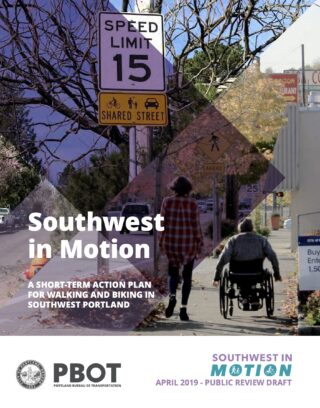
If you care about making streets in southwest Portland better for biking and walking, the Portland Bureau of Transportation has just done you a huge favor.
Yesterday the bureau released the draft version of the Southwest in Motion (SWIM) plan. It’s an impressive, detailed, and easy-to-use blueprint for activism that should lead to projects on the ground in very short order (and help tee up larger projects in the future).
Modeled after similar planning documents for east and northwest Portland, the SWIM plan offers a prioritized list of projects, possible design treatments, and even identifies potential funding sources to actually get things built.
Below is a before-after of what we’ve got in southwest for biking and walking now and what PBOT has called for in this plan:
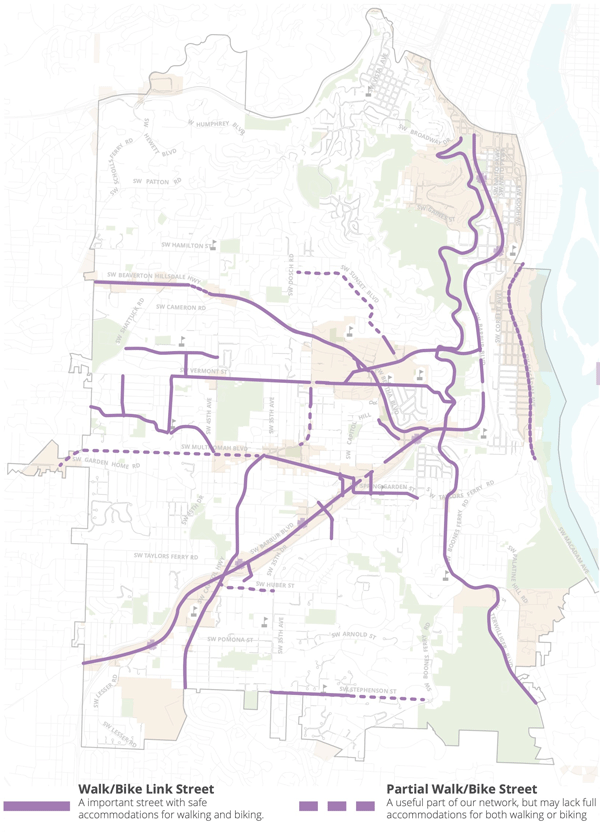
It doesn’t get as much attention as east Portland for how much it lags behind the central city in active transportation infrastructure, but if you’ve spent any time in southwest (like we did during our SW Portland Week coverage in 2015), its challenges and deficiencies for biking and walking are abundantly clear. A lack of continuous streets, hilly topography, and narrow roadways make mobility very daunting for anyone who’s not using a car.
According to U.S. Census data, 65% of southwest Portland residents drive alone to work. That’s 7 points higher than the citywide average. Another big difference from east Portland? Census tracts within the project area are also richer (median household income is $89,578 versus $61,118 citywide) and whiter (percent person of color is 15% versus 26.9% citywide).
With that bit of context, here’s why I’m excited about this plan…
Is it any good? And the “Falbo Factor”
“SWIM is a big step in the right direction.”
— Eric Wilhelm, Hillsdale resident
The PBOT project lead is one of their brightest new planners, Nick Falbo. Prior to being hired by PBOT, Falbo gained notoriety for creating protected intersections for bicycle users. While employed by Alta Planning + Design, Falbo created a nifty web tool that allowed us to experiment with Portland’s cycling mode share goal in an interesting new way.
While he’s still learning to balance the politics and public pressures that accompany groundbreaking new designs, this plan is a showcase of Falbo’s talents. I’ve seen a lot of PBOT plans over the years — and I often think they should do more building and less planning in general — but this SWIM draft is really great.
If you’re an independent activist, a neighborhood advocate, or a non-profit staffer, you now have an invaluable tool to push for changes. PBOT themselves makes this clear in the plan when they say, “Continued community advocacy for projects will be instrumental to the success of this plan… The project descriptions are designed to provide the critical information necessary for neighborhood advocacy of local priority projects. Effective advocacy with the bureau and with local elected officials will provide continued urgency to address the real infrastructure deficiencies of Southwest Portland.”
Eric Wilhelm is an active cycling activist, Hillsdale resident, and member of the Stakeholder Working Group. He wanted PBOT to go even further with road diets and transit priority lanes; but acknowledged in an email this morning that, Wilhelm feels that in addition to a focus on short-term implementation, the best part of the plan is how it tackles current gaps in the network. “We have so many places where the bike lane just ends on a street with fast and heavy traffic or there is no sidewalk to get to a transit stop,” he added.
What’s in it?

The meat of the plan is a list of high-priority, short-term walking and biking projects. PBOT has separated them into “Top Tier” and “Second Tier”. The former are add-ons to existing routes and closing gaps, the latter are larger-scale projects that would expand the network and/or build connections to other major investments (like future SW Corridor light rail or Red Electric Trail).
PBOT has also highlighted key projects and innovative new design treatments (see below). These new designs are key because they remove excuses for PBOT to do nothing in the face of narrow streets or other challenging existing conditions.
The plan also outlines other city programs (like block parties, community plazas, and urban trails) that we can use as leverage to make changes happen.
My favorite part of the plan is when it looks into the future. PBOT points out that since 2010, almost all of the new work trips have been absorbed by modes other than driving. “Driving in Southwest has plateaued,” they write, “and the other travel options have picked up the slack.” There’s also a nifty chart that envisions that trend continuing into the future (below). The chart includes predictions that will impact transportation. In 2021, PBOT says, “Major innovations in electric micro-mobility technologies allows for wide-spread adoption. These new e-bikes allow a greater share of Southwest Portlanders to overcome barriers to cycling such as hilly terrain and longer distances.”
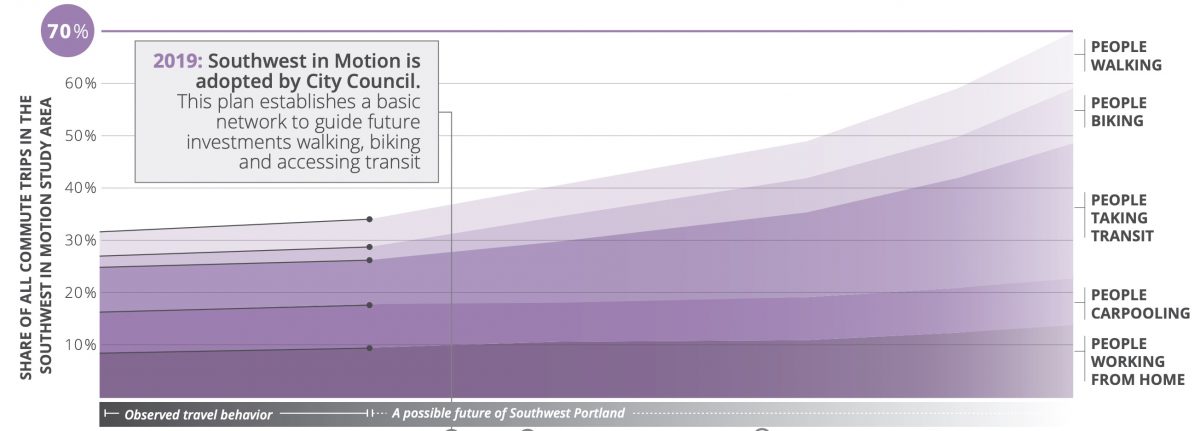
Design treatments
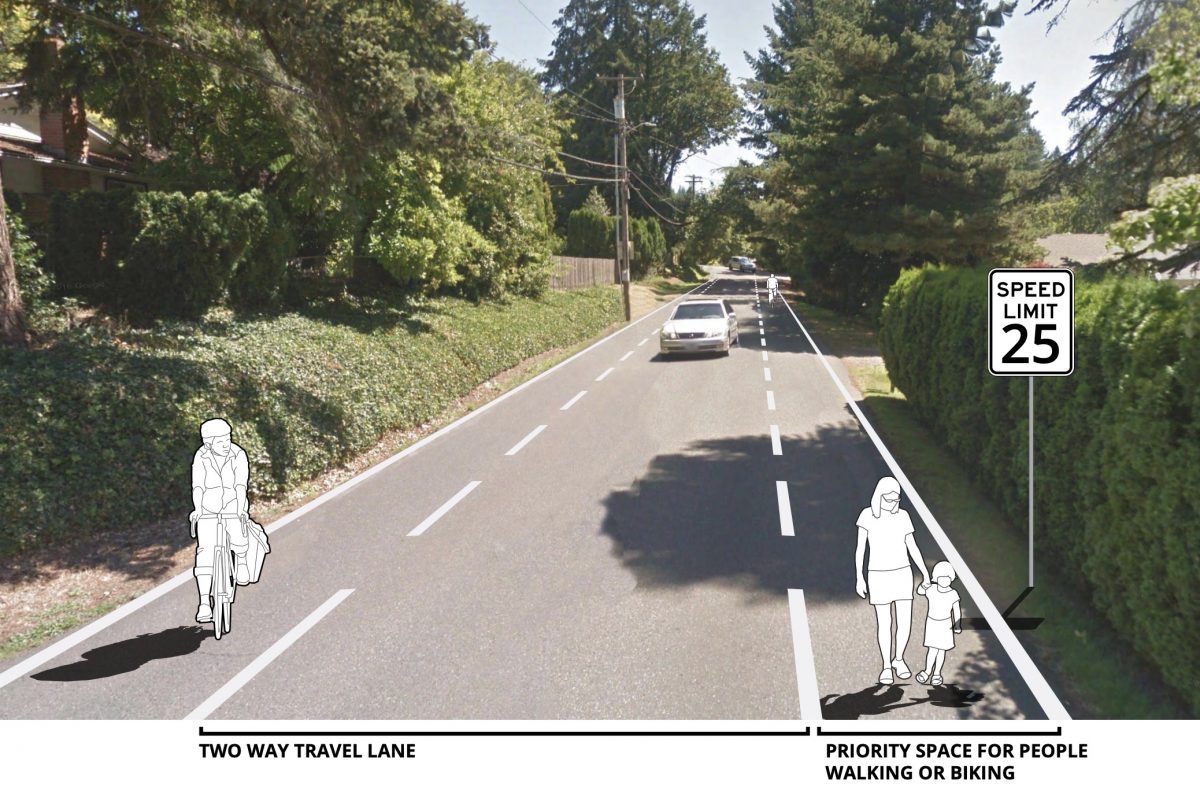
PBOT has put some cool new treatments on the table in this plan.
Advisory shoulders (a.k.a. advisory bike lanes) have been talked about for years, but the city has yet to pull the trigger on them. These are used on slower, low-volume roads that are are “too narrow” for bike lanes. The idea is to create suggested shoulders that car drivers are allowed to venture into if necessary; but otherwise provide some safety and space for walkers and bikers. PBOT wants to find a good pilot street to test them prior to rolling them out citywide. A potential location for these is SW Fairmount or SW Hewett.
“Safer Shoulder” (below) is another new treatment in the plan. PBOT says they’d, “provide a separated place to walk on a roadway, out of the path of moving traffic.”
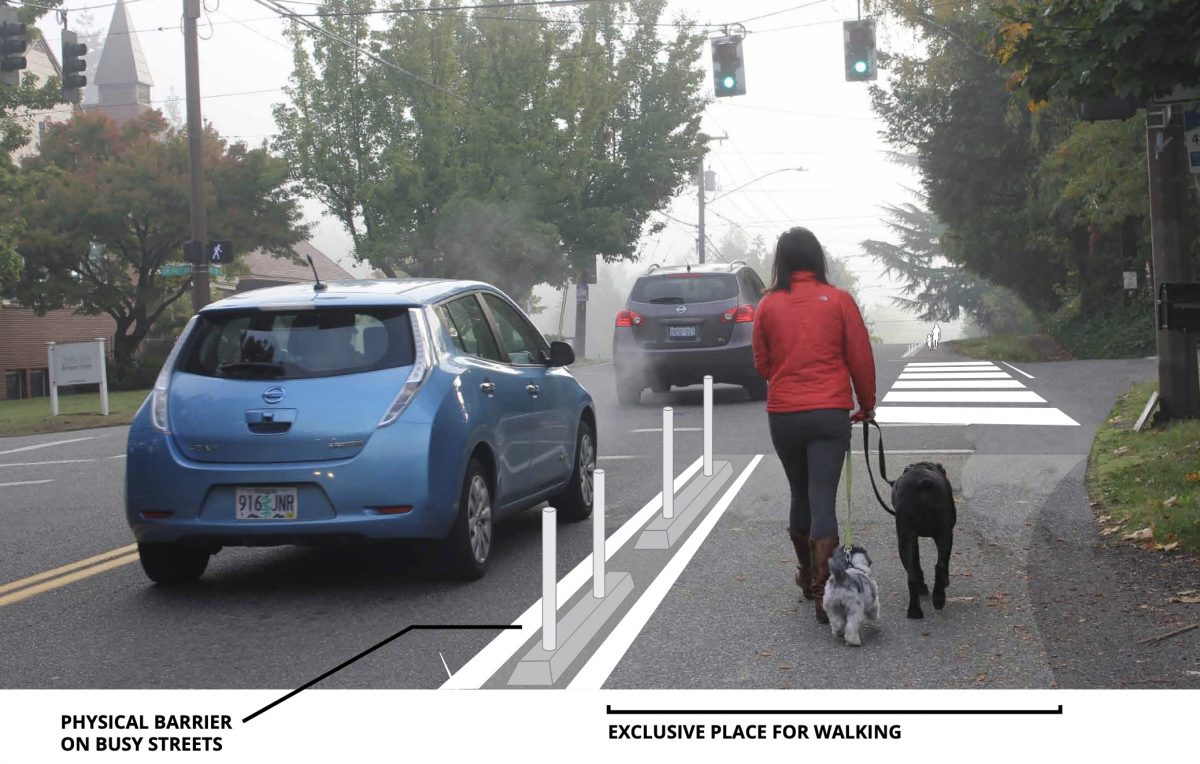
Notable projects

(Photo: Jonathan Maus/BikePortland)
This plan doesn’t just have aspirational project lists. There are several things that could be built quickly.
PBOT says they have funding allocated for protected bike lanes on SW 35th and SW 45th avenues. On 35th, they will remove a parking lane and center turn lane to make room for protected bike lanes that connect Jackson Middle School to SW Huber Street. On SW 45th, PBOT wants to remove a parking lane and stripe bike lanes from SW Pendleton to Nevada to connect the Hayhurst neighborhood to Gabriel Park.
Another project identified in this plan is a long-awaited fix for SW 6th Avenue as it crosses I-405 and enters the central city (below). PBOT says it’d cost just $15,000 re-stripe the existing lane as it approaches SW College Street to provide a more continuous bikeway and eventually tie it into a Central City in Motion project slated for SW Jackson.

How about a neighborhood greenway on SW Montgomery from downtown to Fairmount? That’s project RP-26. It would add greenway treatments on Montgomery from SW Vista to Talbot to help make a safer connection between downtown and the popular Fairmount/Council Crest Park look.
During our “Gap Week” coverage in 2016 we singled out the dropped bike lane on SW Terwilliger near 7th. I was pleasantly surprised to see this address as project BP-20. Surely we can find $150,000 to do this!
While actionable projects are great, we also need big visions. At one of their open house events, PBOT shared a poster titled, “Major Projects for Future Study”. Among the exciting projects on the list was the “Southwest Cycle Superhighway” which would be a low-stress bikeway to be built as part of the SW Corridor light rail project (below).
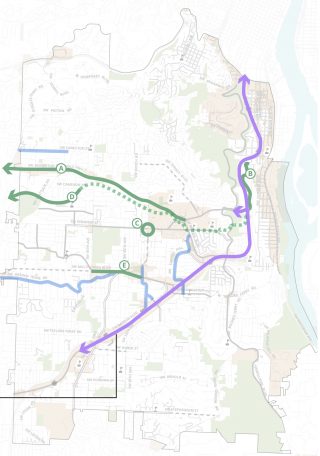
How we gonna’ pay for all this?!
PBOT says the prospects for future funding are “promising, but uncertain.” But unlike others plans, PBOT doesn’t leave southwest hanging with no dedicated funding. They list $935,000 in a mix of one-time ($185,00 for bicycle lanes, $550,000 for crossing enhancements via Fixing Our Streets program) and annual ($200,000 through their existing “quick build network completion” program) funding. Other potential sources of funds PBOT calls out in the plan include: Federal “flexible funds”, Metro’s 2020 transportation investment bond measure, Transportation System Development Charges and a new Local Transportation Improvement Charge program.
Portlanders are tired of plans. We want to build things. Hopefully this plan helps us do that faster.
Let’s take PBOT’s hint and use it to our advantage. Here’s what you need to help:
– Official SWIM project page.
– Draft SWIM plan. (PDF)
– Draft project list. (PDF)
– Public feedback survey open until May 24th
– Stay tuned for City Council adoption date.
— Jonathan Maus: (503) 706-8804, @jonathan_maus on Twitter and jonathan@bikeportland.org
Never miss a story. Sign-up for the daily BP Headlines email.
BikePortland needs your support.
